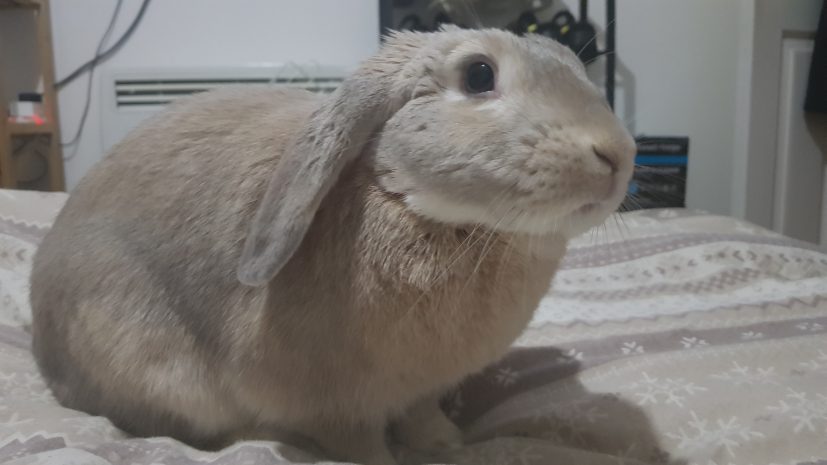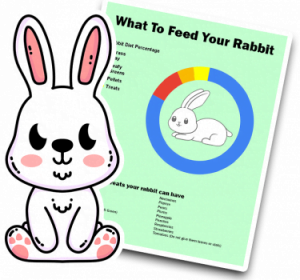
If you’re thinking about getting a pet rabbit or just curious about these fluffy creatures, you might wonder how big rabbits get. Well, the answer to that question is not so simple. Rabbits come in various sizes, and the specific breed and individual rabbit will ultimately determine how big they can get. In this article, we will explore the different breeds of rabbits and their sizes to give you a better understanding of how big rabbits can get.

Technically, a pet rabbit has no ‘average’ size since their size ranges depending on their breed. Rabbits tend to be referenced by weight when discussing their size.
It’s worth noting that, unlike many other species, male and female rabbits of the same breed are often very similar in size.
A small breed may be perfect if you are looking for a rabbit that won’t take up much space and is easy to handle. Here are some of the most miniature rabbit breeds:
The Netherland Dwarf is one of the smallest rabbit breeds, weighing only 2-2.5 pounds when fully grown. This breed is known for its compact size, cute round face, and playful personality. They are also popular show rabbits, with many different colors and patterns to choose from.
The Holland Lop is another small rabbit breed, weighing around 3-4 pounds when fully grown. This breed is characterized by its floppy ears and gentle temperament. They make great pets, especially for children, as they are easy to handle and have a calm and friendly demeanor.
The Mini Rex is a small rabbit breed known for its soft and velvety fur. They weigh around 3-4 pounds when fully grown and come in many colors. This breed is also popular for its docile and affectionate personality, making them great pets for families and individuals.
A medium-sized breed may be right if you want a rabbit that is not too small or too big. Here are some of the most popular medium-sized rabbit breeds:
The Lionhead is a medium-sized rabbit breed named after its distinctive fur mane around its head. They weigh around 3-4 pounds when fully grown and come in many colors. This breed is known for its playful and curious personality, making them great pets for those who want an active and engaging companion.
The Dutch are another medium-sized rabbit breed known for its distinctive markings. They weigh around 4-5 pounds when fully grown and have a gentle and sociable personalities. This breed is also easy to train and handle, making them great pets for beginners and experienced rabbit owners.
Polish breeds are small to medium-sized rabbit breeds known for their cute and compact body. They weigh around 2.5-4 pounds when fully grown and come in many colors. This breed is characterized by its lively and curious personality, making them great pets for those who want a rabbit with lots of energy and playfulness.
If you want a big and impressive rabbit, then a large breed may be just what you are looking for. Here are some of the largest rabbit breeds:
The Flemish Giant is the largest rabbit breed, weighing around 13-14 pounds when fully grown. They are characterized by their massive size, long ears, and docile temperament. This breed is known for its gentle and calm personality, making them great pets for those who want a giant rabbit but are still easy to handle.
The Checkered Giant is another large rabbit breed, weighing around 9-12 pounds when fully grown. They are known for their distinctive black-and-white markings and friendly and outgoing personality. This breed is also active and playful, making them great pets for those who want a big, full-of-energy rabbit.
The French Lop is a large rabbit breed that weighs 10-15 pounds when fully grown. They are known for their massive size, floppy ears, and calm demeanor. This breed is great for families as they are gentle, loving, and enjoy interacting with humans. They have a sweet and gentle nature and are a popular choice as pets.
If you have a young rabbit, you might wonder how big they will get when they reach adulthood. The most reliable way to tell how big your rabbit will get is by researching their breed. The table from earlier will give you an idea of the average weight your rabbit might reach.
If you adopt or rescue a rabbit, you may not have a lot of information about them. If you are unsure what breed your rabbit is, you may be able to work it out by doing some research online. Your vet should also be able to give you some guidance.
If you know your rabbit’s age, you also use this to estimate their adult size. When a rabbit is around 4 months old, they’ll be about half the size they will be as an adult. When they’re about 6 or 7 months old, they’ll be about two-thirds of their adult size, so don’t have much more growing to go. While this isn’t exact, it’s a good way to get an estimate.
Knowing how big your rabbit will get is important because you need to ensure they have a large enough enclosure to accommodate them when they reach their adult weight. Most pet shop cages and hutches aren’t large enough for a rabbit to live happily. They need plenty of space to stretch out, move around, and play.
Since we’re talking a lot about rabbits’ weight in relation to their breed and adult size, you are likely wondering how to weigh your rabbit. The best way to get an accurate weight for your bunny is to take them to your vet to get weighed.
Your vet will have specialist scales and can weigh your rabbit accurately. They can also let you know whether your rabbit is at a suitable weight for their breed and perform a health check.
If you want to weigh your rabbit at home, you could use simple home scales to weigh yourself. Then simply stand on the scales holding your rabbit and note the weight of the two of you. Subtract your weight, and you’ll be left with your rabbit’s weight.
Dr. Amir Maurer from the Companion and Exotic Animal Veterinary Center in Holon, Israel, explains that you can also use kitchen scales with a plastic basket or container on top to hold your rabbit. Of course, this depends on the size of your bunny. Since rabbits will move around a lot, weighing them three times and then working out an average is essential.

Rabbits reach their full adult size by the time they’re a year to 18 months old. They won’t continue to grow after this point, so if you notice they’re gaining weight after this time it’s important to take your rabbit to visit the vet.
Rabbits need to maintain a balanced weight to stay healthy, and they may be overweight. Your vet will be able to check and give you advice on whether you need to change your rabbit’s diet.
Ensuring your rabbit maintains an appropriate weight is key to ensuring they’re healthy. Rabbits who are overweight are at risk for a number of health issues. The correct diet and plenty of exercise will ensure your rabbit stays healthy.
Providing your rabbit with a healthy diet is crucial. Vet Anna Meredith says that feeding a rabbit the correct diet is the most important factor in keeping them healthy.
Your rabbit should have access to plenty of high-quality hay, some vegetables, and a small number of complete rabbit pellets each day. It’s important not to overfeed and to avoid ‘mixes’, as your rabbit will likely pick out their favorite parts and leave the rest. This means their diet isn’t balanced.
You should always do your research to ensure any vegetables you feed your rabbit are safe and healthy for them. Check out our detailed guide on what you should feed your rabbit.
Just like humans, rabbits need exercise to stay healthy. Ensure your rabbit has plenty of room in their living area to move around. They should also have time out of their enclosure each day with as much space as possible to run around and play.
You can encourage movement by providing toys and games to keep them interested, as well as by interacting with them. This is also really important for their mental health. Happy rabbits are likely to eat and move around more!
Keep in mind that rabbits are crepuscular, which means they’re awake mostly at dawn and dusk. Offering plenty of stimulation during these times when they would naturally be more active can encourage more movement.
Choosing the right rabbit breed for you can be a daunting task, but it is important to make sure you choose the right one for your lifestyle and living situation. Here are some factors to consider when choosing a rabbit breed:
References

By entering your email address you agree to receive emails from Cottontailclub. We'll respect your privacy and you can unsubscribe at any time.